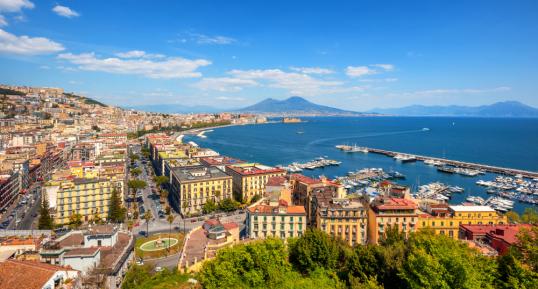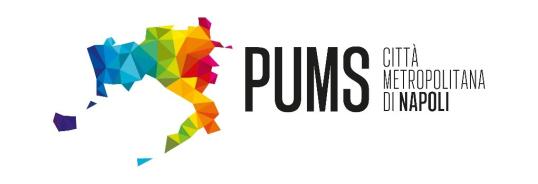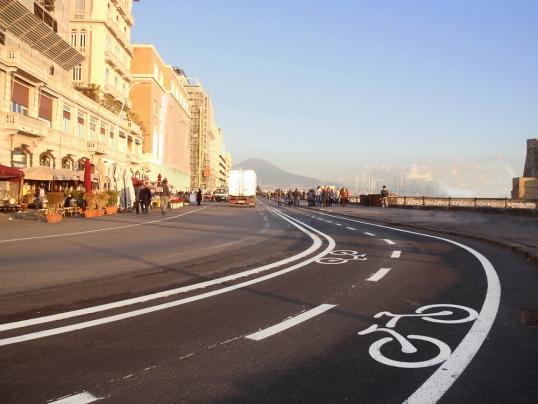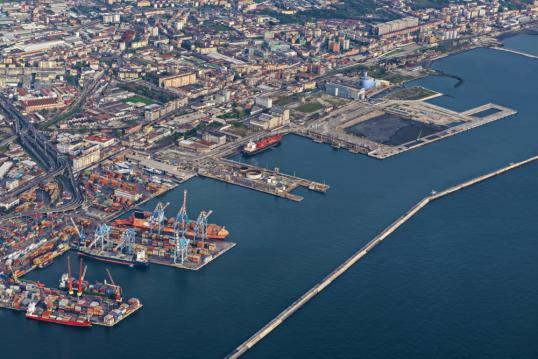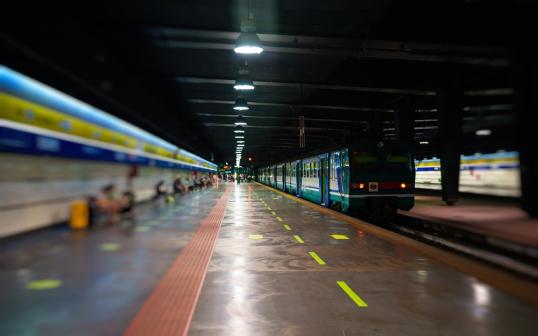- Topic
- Urban mobility planning
- Country
- Italy
- Resource type
- Case study
First published on 20 February 2023.
Naples is an Italian metropolitan city in the Campania region. In 2021, the Metropolitan City Authority started the process of its Sustainable Urban Mobility Plan (SUMP) aiming to develop a more harmonious, balanced, and integrated urban plan. The SUMP falls within the competences of the Metropolitan Authority’s departments for environmental protection, urban planning and mobility, socio-economic development, education, equal opportunities, and safety.
The SUMP of the Metropolitan City of Naples adopted in October 2022 is in line with the recently updated EU SUMP Guidelines and the Italian SUMP guidelines. The national legislation indicates four main objectives: 1) effectiveness and efficiency of the mobility system, 2) energy and environmental sustainability, 3) road mobility safety, and 4) socio-economic sustainability.
The SUMP aims to provide the metropolitan city with an integrated transport system, with a specific emphasis on four main topics:
- cycling mobility
- mobility for people with disabilities
- urban freight
- local public transport
Context
The Metropolitan City of Naples is Italy's third most populated city, comprising 92 municipalities. The metropolitan area of Naples is the smallest in terms of area amongst all 14 Italian metropolitan cities, however it is the city with the highest population density. Its high level of urbanisation contributes to a strong territorial and demographic imbalance.
Naples is one of the most compact and congested cities in Europe. Additionally, because of its proximity to the volcano Vesuvius and the Phlegraean Fields, the entire territory is vulnerable to seismic and volcanic activity.
Developing the SUMP for the Metropolitan City of Naples was a complex planning exercise. Despite being a TEN-T Node, this functional urban area (FUA) is characterised by a lack of infrastructure and poor transport connections to the city of Naples, accompanied by an increase in commuting trips, traffic congestion and subsequent air pollution. Furthermore, the city offers limited opportunities for active modes of transport (walking/cycling), and few shared mobility services are available.
A multidisciplinary team, led by Sintagma and with the participation of TPS Pro and TRT Ingegneria, supported the Metropolitan City of Naples in the development of its SUMP.
In action
The methodological approach is based on an analysis of homogeneous zones, created by aggregating municipalities with similar historical, geographical and socio-economic contexts, as well as urban mobility and logistics requirements. The territory was examined in a balanced and integrated way, taking into account the peculiarities of each municipality and territory.
The analysis of the territorial framework was enriched by the participation of residents and stakeholders (e.g. cycling and environmental associations), which allowed for the definition of specific objectives and measures aiming to achieve balanced and sustainable development. Several interviews and workshops were organised between December 2021 and July 2022. For the metropolitan cycling plan, an online web map was created to enable people to geo-localise roads and intersections that were in need of safety improvements for pedestrians and cyclists. Regarding the accessibility and mobility of people with disabilities, the participatory process involved the relevant institutions, mobility services providers, and associations.
The SUMP of the Metropolitan City of Naples integrates hard measures (e.g. infrastructure) that were already approved and funded by the National Recovery and Resilience Plan (NRRP) with local policies and soft measures (e.g. education, information, campaigns) supporting the development of sustainable and integrated urban planning.
Therefore, the SUMP of the Metropolitan City of Naples aims to:
- foster intermodality and the use of sustainable transport modes;
- improve direct connections between neighbouring municipalities;
- favour the development of sustainable urban logistics;
- provide integrated ticketing;
- grant equal travel access to people with disabilities or reduced mobility in order to enable unrestricted mobility for all.
Results
The main pillars of the SUMP planning process that were given specific emphasis were cycling, mobility for people with disabilities, urban logistics, and local public transport.
Cycling plan
The presence of natural areas and cultural landmarks provide the potential to develop attractive cycle tourist itineraries for the local community, national and international tourism. Cycling mobility contributes to enhancing the promotion and preservation of the territory and to improving the connection between municipalities. Many local associations are interested in urban and territorial regeneration, preservation, and accessibility through sustainable and active mobility. As a result, funds have already been allocated to cycling infrastructure in the Phlegraean area and the use of e-bikes has increased in the islands.
Despite the promising measures, the metropolitan area lacks an integrated cycling network of connected, protected, and marked bike lanes. The few existing bike lanes are isolated and unsafe as road signs are often missing. Cycling services and stations, and shared micromobility services, are also non-existent. There is no modal integration with local public transport, and this negatively impacts road safety, as well as the propensity to use sustainable transport.
Considering the high rate of short trips, there is an opportunity to increase the demand for active mobility and boost cycling with the adoption of the National Cycling Paths Programme (Ciclovie Nazionali). The long period of restrictions implemented during the pandemic showed that protecting cycle paths and limiting traffic, vehicle parking and access for private vehicles in urban centres, as well as reducing their speed, are simple interventions favouring inclusive and cycling mobility.
The SUMP identified the following strategies and measures for cycling mobility:
- Design an urban cycling network for the metropolitan city (Bicipolitana) accessible to all ages and abilities, going beyond the logic of fragmented interventions, which included defining priority, secondary and green cycle paths;
- Integrate with the national cycling network, granting connections with multimodal nodes and inter-municipal accessibility to areas of interest;
- Ensure modal integration with all transport modes;
- Introduce regulation and policies in favour of the territorial continuity of cycle paths in urban areas (e.g. through the introduction of urban vehicle access regulation schemes;
- Implement a network of dedicated parking areas, cycling stations and services in public transport stations and areas of interest;
- Make bike lanes safe.
In order to support these measures, it is crucial to monitor policies and measures before and after their implementation to evaluate their efficiency and to support their development. It is also essential to ensure a participatory process involving local associations, stakeholders, and residents, as well as support from local authorities.
Accessibility and mobility for people with disabilities
The current transport services are slowly improving their accessibility (e.g. by providing sensorial and acoustic information, lifting equipment, warning
strips, tactical directional signs and maps) in public transport stations of the city of Naples. People with disabilities, (visual/hearing) impairment or people with reduced mobility can reach areas of historical-cultural interest by using local public transport services, with reduced tariffs.
Nonetheless, universally accessible spaces and itineraries are still lacking. Users face difficulties in finding appropriate information to undertake a trip, especially if this entails a change of transport mode or operator. Designated parking spots are often lacking or illegally occupied. Additionally, on-demand transport services for people with reduced mobility are insufficient, special assistance services are scarce and the personnel is insufficiently trained. Many public transport services are inadequate (broken electric lifting ramps, low frequency of service in the day, no service during the evening). Consequently, people with reduced mobility have many reasons for not using public transport (e.g. physical barriers, insufficient information, security concerns, lack of self-confidence, costs). Transport operators barely cooperate, and their services are not integrated. Furthermore, school transport is available solely to children at the primary and middle school levels. People with reduced mobility report a sense of social exclusion and lack of sensitivity from institutions.
Fortunately, local associations are dynamic and collaborative, often providing what is missing and should be provided by local authorities or transport operators. In order to remove architectural, orientation, and communication barriers, a long-term urban strategic plan should be envisioned that defines a clear participatory process, establishes the role of the disability manager in companies and local administrations, and allocates economic resources and specific funds to this sector. On-demand services could be developed to complement traditional local public transport services.
The SUMP participatory process helped to define policies and measures for the mobility of people with reduced mobility. These include measures to improve universal accessibility to local public transport services and remove architectural barriers. Universal mobility also requires changes to the urban environment, meaning secure and accessible road crossings, “barrier-free” stops, lifts in public transport stations, and the removal of the gap between the train and the platform. Furthermore, mobility also goes beyond infrastructure: information (inclusive intelligent transport systems (ITS)), in digital formats also needs to become more accessible. Finally, it is crucial to monitor interventions to guarantee autonomous travel for people with reduced mobility and increase awareness on the issue of social inclusion.
The SUMP identified the following measures to improve mobility for people with reduced mobility:
- Removal of infrastructure and barriers (co-planned with people with reduced mobility);
- Information and communication (e.g. electronic information boards, verbal information, mobility service apps and websites, easy-to-read timetables, archive of all reported service and technical problems);
- Organisation and management (e.g. on-demand assistance in stations and on public transport, disability managers in companies and local administrations, fines for illegal parking);
Sustainable and competitive urban logistics
The Metropolitan City of Naples is located in a central position with respect to the commercial and economic dynamics of Southern Italy. It is equipped with important logistics infrastructure: the ports of Naples, the international airport of Naples-Capodichino, and the freight village of Nola.
The analysis underlying the development of the SUMP highlighted solid collaboration between stakeholders for the development of projects. However, some missing interconnections limit the strategic potential of logistics in the area. For instance, the port of Naples is not connected to the national railway network. The airport of Naples has recently developed new areas for logistics services, but it has limited possibilities to increase these activities as it is in a densely urbanised area and because of the passenger traffic that dominates flights at the airport. Traffic congestion also negatively affects the daily operations of businesses, resulting in extra costs from time lost and decreased productivity. Loading/unloading areas are often scarce or illegally occupied by private vehicles, and couriers are generally located outside of the city. Fortunately, more and more operators are adding electric vehicles to their fleets, although the number of recharging points for these vehicles is still insufficient.
Therefore, in order to reduce traffic congestion and air pollution, and encourage sustainable logistics, the SUMP favours intermodality, including by improving connections between the ports and freight village and the rail network. Strategic infrastructure also needs to be developed, e.g. urban distribution centres equipped with electric vehicle recharging points. Investments are essential to develop new sustainable technologies.
The general objective of the SUMP is to improve the quality of logistics services in the metropolitan area, improving simultaneously their social, economic and environmental performance, while increasing the competitiveness of the local area.
The SUMP proposes:
- Regulatory and political measures (e.g. favouring the renewal of fleets, urban access restrictions, policy incentives for cycle logistics);
- Infrastructural measures (e.g. creation and development of urban distribution centres, pick-up points, and urban micro-hubs in the outskirts of the city of Naples, equipped for low emission and electric vehicles to optimise deliveries);
- Technological and organisational measures (e.g. ITS systems for flow optimisation and fleet monitoring);
- Dissemination activities and campaigns on sustainable mobility (e.g. awareness campaigns, regular meetings with stakeholders).
Local public transport
The metropolitan area is equipped with extensive transport infrastructure. As mentioned, Naples is part of the TEN-T core network, with its airport, ports, high-speed railway, highways, and freight village. This infrastructure provides international, national, regional, and local connections for passengers and freight. However, few sharing mobility services are available (i.e. collective taxis, car-pooling). Additionally, technological renewal of the rolling stock is currently on-going, along with the development of new interchange nodes, stations, and connections. Finally, integrated ticketing is also being slowly provided (i.e. rail-bus tickets).
However, some major connections are still missing (e.g. airport and port high-speed railways, port-highways, port freight villages) as well as on-demand services. Alternative energy sources for vehicles are lacking. The rolling stock is old and polluting and stations are often inaccessible. The public transport provider EAV has a narrow-gauge railway, which impedes interconnections, and the metro in Naples runs a low frequency service. Finally, mobility as a service (MaaS) systems have yet to be implemented.
Therefore, the SUMP aims to boost the existing public transport lines and introduce new ones, especially in areas with the potential to attract new collective public transport users and reduce the use of private vehicles, which have dramatically increased over the past decade. In order to encourage intermodality, it is also crucial to improve integration between different public transport modes (existing, planned, and proposed) in the metropolitan area, optimise the public transport network (air, rail, maritime, collective transport) through the reorganisation and calibration of the public transport offer, and provide a more reliable public transport service offer.
The SUMP defines the following strategies for public transport:
- Air: improve airport connections and promote the development of aerial connections with the islands with vertical take-off and landing aircraft between the main airports, helipads, and ports;
- Rail: increase the intermodal efficiency of the rail networks that are currently not interoperable in the metropolitan area; accelerate and increase rail infrastructure capacity, coherent and functional to the operating model adopted for the regional rail transport where the offer does not meet the demand; and decarbonise rail transport with interventions on the infrastructure of the local public transport operators and progressive conversion of rolling stocks;
- Maritime: support the development of alternative energy sources at the ports, improve the ports’ collective public transport network (road and high-speed railway) connections, accelerate passenger connections with the islands, and facilitate intermodality with local public transport;
- Collective transport: identify (e.g. rural) areas with low demand and provide them with a network of essential services and close interchange nodes.
Challenges, opportunities and transferability
As the Covid-19 pandemic and the development of the SUMP overlapped, most of the stakeholder engagement activities were carried out online. As the proposed measures are implemented, the liveability of the metropolitan area and, therefore, the quality of life is expected to improve. In addition, the Plan’s adoption and implementation will facilitate access to national and EU funds for urban mobility.
Transport modelling was crucial to analyse the current mobility network, the transport offer and demand, and to develop the SUMP’s future scenarios. The adopted methodology, the participatory process, and the alignment with the European and national SUMP guidelines are elements that helped develop the objectives, strategies, and measures for the Metropolitan City of Naples’ SUMP. This analysis is key to support the local administration in choosing how to allocate resources and identify its priorities.
In Depth
Sustainable Urban Mobility Plan of the Naples Metropolitan Area website (in Italian).
For more specific, relevant information about the SUMP of Naples Metropolitan City, please contact:
Valeria Vanella: vavanella cittametropolitana [dot] na [dot] it (vavanella[at]cittametropolitana[dot]na[dot]it)
cittametropolitana [dot] na [dot] it (vavanella[at]cittametropolitana[dot]na[dot]it)
Simone Bosetti: bosetti trt [dot] it (bosetti[at]trt[dot]it)
trt [dot] it (bosetti[at]trt[dot]it)
SUMP Office, Naples Metropolitan City: pums cittametropolitana [dot] na [dot] it (pums[at]cittametropolitana[dot]na[dot]it)
cittametropolitana [dot] na [dot] it (pums[at]cittametropolitana[dot]na[dot]it)
Photo Credit: © Boris Stroujko, Carlos Amarillo, ThomasLENNE, M-Production - no permission to re-use image(s) without separate licence from Shutterstock.

